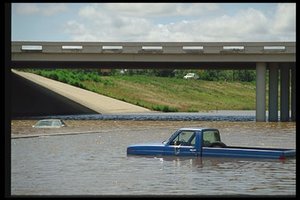Variables affecting water yield

There is a direct relationship between the amount of water available in a watershed, climate, and climate variability. The fraction of precipitation that will reach stream channels depends on the amount and type of vegetation cover, the physiography, and land use(s) of the watershed. Climate is responsible for precipitation quantity, intensity, and duration, as well as storm distribution within a watershed, the results of which significantly impact streamflow regimes and the annual hydrograph. As an example, when a relatively large storm occurs in the upper part of a sufficiently large watershed, the resulting hydrograph will exhibit a lower peak flow, longer time base, and a slower rise to peak. Higher elevations also undergo potential snow deposition processes (depending on season), which can also affect the hydrograph by lowering and broadening it. In watersheds having sufficiently cold temperatures, usually in higher altitudes, snowfall accumulates forming snowpack, and no significant overland or subsurface runoff is displayed until snowmelt. In the event of an extreme warming event, rapid climate-induced rain, wind, and subsequent snowmelt (rain on snow, ROS) can result in flashfloods with often costly and disastrous consequences for communities located in the floodplain. This response is less likely at lower altitudes where temperature and atmospheric humidity are usually warmer, and evapotranspiration (ET) tends to reduce the soil moisture content, resulting in a reduced streamflow and increased storage capacity in the soil reservoir.
Different species of vegetation will affect water yield differently. For example, the ET of a hardwood forest is considerably less than that of coniferous forest. This is explained by differences in leaf area index (LAI) resulting in varying interception, evaporation and transpiration processes. A canopy with a higher LAI will intercept more rainfall and generate greater evaporation. Additionally, canopy density is directly correlated to the amount of water that is drawn from the soil and released into the atmosphere through plant transpiration. If, for example, the LAI for a given hardwood is 1 compared to an LAI of 10 for pine, one can expect that the soil water losses via transpiration will be greater for the pine. Similarly, species conversion in a given watershed will affect water yields. Studies have shown that converting hardwood to pine can reduce the annual, seasonal, and monthly water yield.
Topography can greatly affect streamflow and the shape of a hydrograph through direct impacts on the watershed’s response to precipitation. The shape of the hydrograph is influenced by watershed characteristics such as slope, shape, size, elevation and soil. A steeper slope is usually characterized by shallower soil depth and increased overland runoff that moves at higher velocities. Some soils allow better water infiltration, which can also impact the hydrograph by lowering the peak flow and broadening its time base. The response of smaller [[watershed]s] is sensitive to high rainfall intensity while the response of larger watersheds is dominated by soil reservoir storage capacity. The hydrograph of small watersheds usually displays sharp and narrow peaks while larger watersheds have broader peaks with a longer time base. Rainfall to runoff ratios also change depending on the elevation (i.e., quantity of rain to quantity of runoff). For example, low-elevation watersheds have a gentle slope and deeper soil and lower rainfall/runoff ratios relative to high-elevation watersheds with steep slopes and shallow soils, which exhibit much higher rainfall/runoff ratios.
Land use has a direct effect on the portion of precipitation resulting in runoff. Vegetation cover has a direct influence on the quantity of precipitation that reaches the forest floor and the quantity that is accumulated as snowpack and/or soil moisture. Forest cutting usually results in an increase in water yield. As an extreme example, during urban development, trees are often replaced by pavement. In this case there is very little accumulation of water in the soil reservoir, and almost all rainfall results in direct surface runoff. As pavement deteriorates and cracks, or as trees grow back in the years following harvest (afforestation), soil reservoirs gradually recharge, and water yield tends to decrease thereby returning to previous flow levels.
Further Reading
- Bosch, J.M. and Hewlett, J.D., 1982. A review of catchment experiments to determine the effect of vegetation change on water yield and transpiration. Journal of Hydrology, 55:3-23.
- Chang, M., 2002. Forest hydrology: An introduction to water and forests, CRC Press, 373 pp.
- Cheng, J.D., 1989. Streamflow changes after clear-cut logging of a pine beetle-infested watershed in southern BC, Canada. Water Resources Research, 25(3):449-456.
- Hibbert, A.R., 1967. Forest treatment effects on water yield. In: W.E. Sopper and H.W. Lull (Editors), International Symposium For Hydrology, Pergamon, Oxford, 813 pp.
- Horton, R.E., 1933. The role of infiltration in the hydrologic cycle. Transactions of The American Geophysical Union Fourteenth Annual Meeting, Washington, DC, pp. 446-460.
- Slaymaker, O., 2000. Assessment of the Geomorphic Impacts of Forestry in British Columbia. Ambio, 29(7):381-387.
- Swift, L.W. Jr., Cunningham, G.B., and Douglass, J.E., 1988. Climatology and Hydrology. Forest Hydrology and Ecology at Coweeta. W.T. Swank and D.A. Crossley (eds.). Springer Verlag, New York, pp. 35-55.